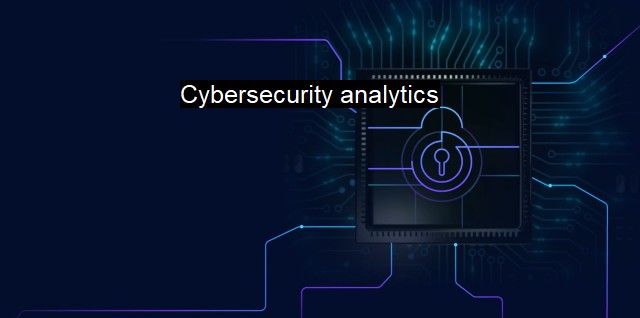What are Cybersecurity analytics?
Empowering Organizations with Cybersecurity Analytics: Mitigating Threats, Identifying Vulnerabilities, and Safeguarding Data
Cybersecurity analytics is an essential aspect of cyber technology that investigates and scrutinizes data related to digital organizations to provide actionable insights for preventing, alerting, and managing cybersecurity issues. Incorporating various forms of data, analytics tools, methodologies, and integration techniques, it is a segment of cyber-defensive operations purposed with building fortified systems that deter unforeseen and unprecedented cyber threats.Cybersecurity analytics focuses primarily on identifying complex patterns linked to any cyber attacks. Recognizing malicious activities that could potentially harm an organization's digital infrastructure forms the crux of pro-active defense against cyber threats. It guarantees an unyielding security posture, seeking to make better-informed decisions contingent on interpreted data rather than on hypothetical scenarios.
Most enterprises have today elevated cybersecurity analytics to the center of their cyber defense initiatives, simply because it aids organizations in real-time identification and mitigation of cybersecurity risks. It does so by continually examining network behavior, system configurations, application data, consumer analytics, and several other essential aspects. Alongside, notifying network administrators and security teams when potential threats are sighted, often strength its efficiency in driving optimal threat intelligence.
One of the significant benefits of cybersecurity analytics is that it can detect even the most minuscule transformations that prove detrimental to an organization's security in the long run. This quality assists in catching breaches in the early stages when they're relatively easier to manage. It utilizes machine learning algorithms and artificial intelligence techniques to identify patterns and analyze behaviors, thereby, hinting when a Cybersecurity event is likely to occur.
It also boosts an organization's responsive ability towards an actual cyber intrusion. Because this specific province of cybersecurity excels in real-time detection and notification, it allows the response teams to act immediately with necessary mitigation steps. The sum benefits: crippling the brewing cyber threat and driving an advantage by incapacitating a threat's evolution.
Despite its significance, cybersecurity analytics still requires a robust setup at its basis—an efficacious cybersecurity program. Fudging the requirements of the key defense program can significantly unravel the effectiveness of the already established analytics system. Its core existence dwelling around threat intelligence and defense strategies, an effective cybersecurity program establishes a foundation and dictates the operations for analytic tools to follow through.
The cybersecurity analytics tools tether with various forms of data soon after a cybersecurity program has been built. While machine learning and artificial intelligence techniques assist these tools in detecting patterns swiftly, the antivirus applications in the system serve as a backbone for detaching malware activities from essential data. Produced insights and alerts, therefore, effectively guard organizations from malware related adversities like cyber viruses, ransomware, trojans, and more.
Particular antivirus applications also offer integrated analytics tools as part of their services. Utilizing predictive modeling techniques, these applications generate higher visibility of the system's vulnerabilities and efficiently drive risk assessment processes. The benefit reflected is better security optimizations owing to real-time notifications direct to system regulators.
It's needless to emphasize the pertinence of implementing cybersecurity analytics in managing a better-informed decision process, demanding only minimal human intervention while enhancing an organization's cybersecurity program’s effectiveness. It aligns better with the bigger picture of establishing a comprehensive cybersecurity protocol focused on fortifying an organization's digital components against potential cyber risks and challenges - bringing the defense against cyber threats to the next level.

Cybersecurity analytics FAQs
What is cybersecurity analytics?
Cybersecurity analytics is the process of using data analytics and machine learning techniques to detect and prevent cyber threats. It involves analyzing large volumes of data from various sources such as antivirus software, network logs, and user behavior to identify suspicious activity and potential security breaches.How does cybersecurity analytics improve antivirus software?
Cybersecurity analytics complements antivirus software by providing additional layers of protection. While antivirus software relies on known virus signatures to detect and block malware, cybersecurity analytics uses advanced algorithms to identify and block unknown threats. This helps to prevent zero-day attacks that can bypass traditional antivirus software.What are some common cybersecurity analytics tools?
There are numerous cybersecurity analytics tools available, including Splunk, ArcSight, and IBM QRadar. These tools provide advanced threat detection and response capabilities by analyzing large volumes of data in real-time. They also offer dashboards and visualizations that help security teams to quickly identify and respond to potential threats.Is cybersecurity analytics only for large organizations?
No, cybersecurity analytics can be implemented by organizations of any size. While larger organizations may have more data to analyze, even small businesses can benefit from using cybersecurity analytics to protect their systems and data. There are also cybersecurity analytics solutions that are specifically designed for small and medium-sized businesses, with affordable pricing and easy-to-use interfaces.| | A | | | B | | | C | | | D | | | E | | | F | | | G | | | H | | | I | | | J | | | K | | | L | | | M | |
| | N | | | O | | | P | | | Q | | | R | | | S | | | T | | | U | | | V | | | W | | | X | | | Y | | | Z | |
| | 1 | | | 2 | | | 3 | | | 4 | | | 7 | | | 8 | | |||||||